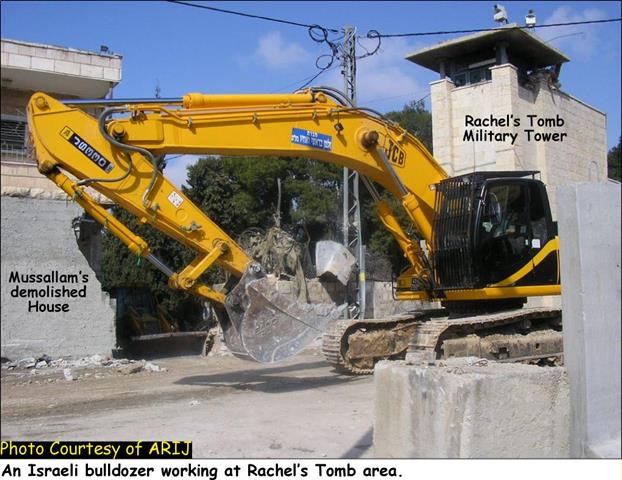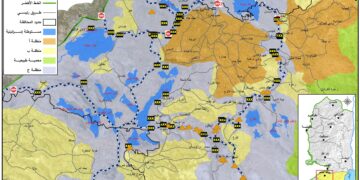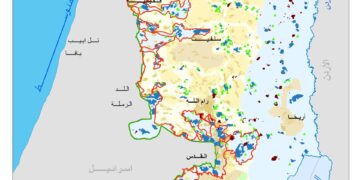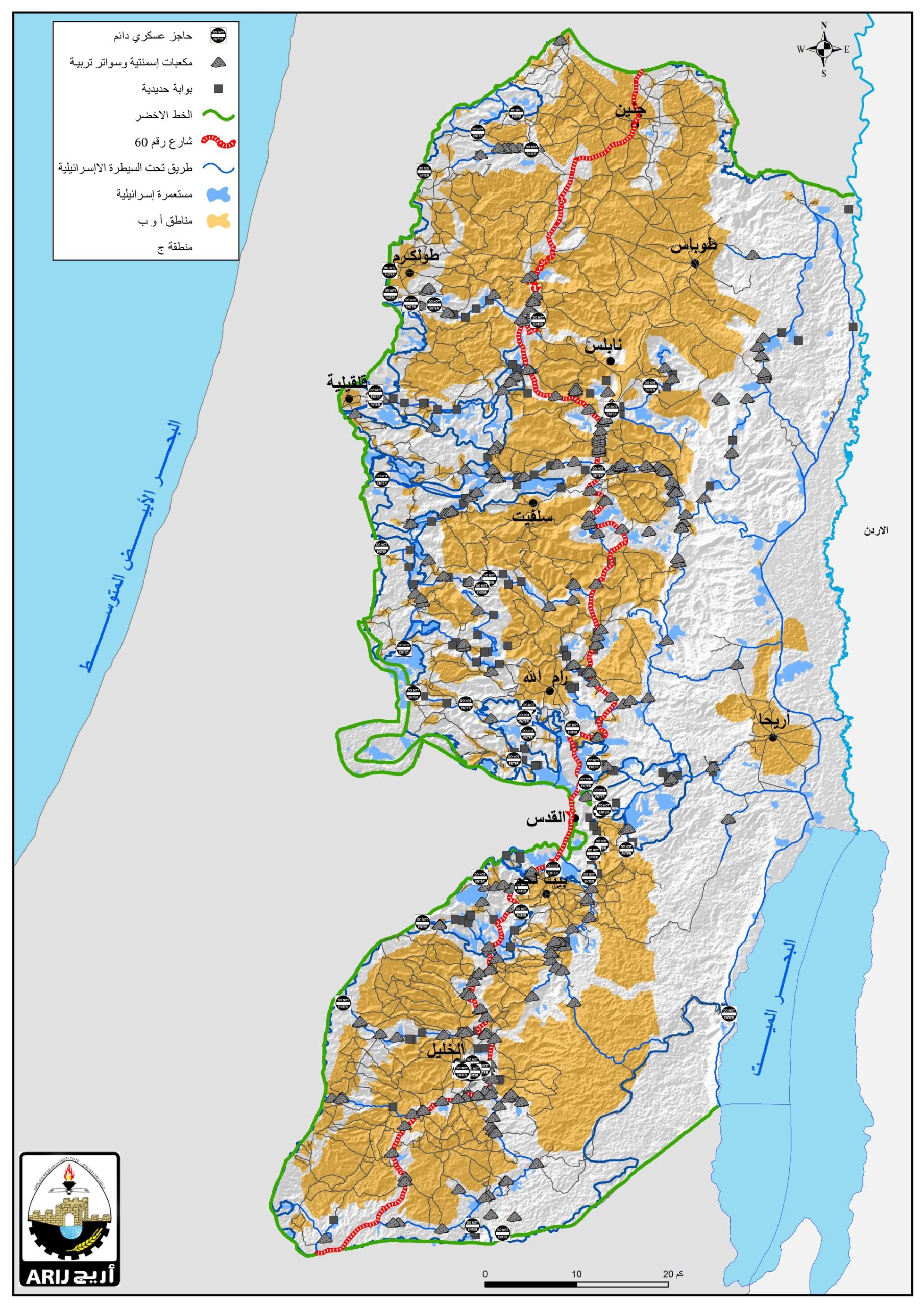The Israeli Occupation forces resumed the Wall constructions at Rachel's Tomb area on February 5, 2006, when a number of Israeli bulldozers backed by Israeli Police Border Jeeps started razing the area close to Rachel's Tomb and demolished part of a Palestinian house that lies next to the Tomb building and belonging to Yousif Mussallam, a Palestinian resident from Bethlehem city. See Photo 1 & Photo 2
The house of Mr. Yousif is currently uninhabited and is being looked after by his brother, Mr. Khalil who works in a coffee shop next to the house. Following the eruption of the second Intifada in September 2000, the Israeli occupation forces closed the road leading to Rachel's tomb area (the main road between Bethlehem and Jerusalem) and prevented Palestinians (Christians and Muslims) from accessing the road and visiting the Tomb in violation to the right of movement, the right of worship and limiting the shrine to Jewish groups and Israeli military use in a primary step to annex the Tomb to Jerusalem.
The House of Mussallam was occupied by the Israeli Forces in the Year 2001, months after closing the road, along with a number of Palestinian houses around the Tomb and transformed them into military posts. On top of Mussallam house, surveillance Cameras were installed and the house was besieged with barbed wires indicating the Jewish presence inside it and was surrounded by huge cement blocks as to prevent access to the area in and around the tomb. Next to the house, is Mr. Yousif's brother coffee shop Mr. Khalil who has been working in his shop for more than four years and had witnessed the loss of his family's property during the current Intifada. His coffee shop was closed many times due to the Israeli practices in the area and the threat of shelling and shooting during the current Intifada. See Photo 3 & Photo 4
Below the coffee shop, is the Blacksmith shop of Mr. Tawfeek Sarhan An Natsheh. Mr. Tawfeek is a father to 10 children and has been working in his shop since 1966. Today, the Wall plan being implemented around Rachel's Tomb area threatens his livelihood since it will enclave the coffee shop along with the blacksmith and families, An Natsheh and Mussallam families will lose their properties and source of incomes. See Photo 5
During the last week, as stated by Mr. An Natsheh, a number of Israeli surveyors and Police Border have visited the site four times where the Israeli Bulldozers are working today and had maps showing the Wall route that is going to be implemented in this area specifically, which is the final Wall section around Rachel's Tomb.
Building of a religious settlement adjacent to Rachel's Tomb:-
On February 3, 2005, the Israeli high court rejected a petition presented by 18 Palestinian families from Bethlehem and Beit Jala cities) against the construction of a bypass to be constructed parallel to the path of the Segregation Wall at Bethlehem's northern entrance, all the way from 'Gilo 300' terminal to reach Rachel's Tomb. The road, accorrding to Israeli sources, is going to facilitate the movement of Religious Jews to Rachel's Tomb area. A week later, the Kever Rahel Fund founder and director Miriam Adani said that the court's decision is the 'first step towards the establishment of a Jewish community around the Rahel's Tomb compound.' as quoted from the JPost daily newspaper on February 11, 2005. TheOccupation of Mussallam's house will enable the Israeli Government from implementing its plans at Rachel's Tomb area by transferring the house into a religious school, only accessed by Jews. daily newspaper on February 11, 2005. TheOccupation of Mussallam's house will enable the Israeli Government from implementing its plans at Rachel's Tomb area by transferring the house into a religious school, only accessed by Jews.
The Wall in Bethlehem Governorate
The Segregation Wall in Bethlehem Governorate is being implemented on stages where certain parts are already completed while other parts are still under-construction or are planned to be constructed.
The Segregation Wall will stretch a length of 52 kilometers on Bethlehem lands and will result in the separation of 73 km² (73,000 dunums) of land, 12% of the total Governorate's area which is 608 km². Already 14.3 kilometers of the Wall in Bethlehem were implemented in the northern parts of Bethlehem Governorate, of which 11.3 kilometers as a fence and consists of military roads, trenches and 60m – 100m width buffer zone fenced with barbed wires, and 3 kilometers concrete wall of 9 meters high.
The Wall around Rachel's Tomb Area
The Segregation Wall around Rachel's Tomb area is in its final Stages. It extends from Gilo 300 terminal to enclave Rachel's Tomb area at the northern entrance of Bethlehem city and stretches a length of 1.3 kilometers, comprising about 3% of the total Wall length in Bethlehem Governorate (608 km²). See Map 1

Map 1: The Wall around Rachel's Tomb area.
A separate road was constructed along the Segregation Wall for the Jewish people coming from Jerusalem and heading to Rachel's Tomb area who don't have to wait in queues to be allowed to enter through Gilo '300' terminal but rather drive into the road already constructed alongside the Segregation Wall which reach a gate constructed north of the Tomb area and guarded by the Israeli soldiers that is solely used by the Jewish buses/cars and military forces. See Photo 6
The Segregation Wall in International Law
Israel's policies in the Occupied Palestinian Territory (OPT) comprise a crime of apartheid according to the International Convention on the Suppression and Punishment of the Crime of Apartheid (1973) which defines apartheid as: 'the imposition of various legislative measures on different racial groups while injuring the rights of one. Moreover, the crime of Apartheid comprises a 'crime against humanity' and 'a serious threat to international peace and security'.
It is a flagrant violation of international humanitarian law, specifically The Hague Regulations of 1907 and the Fourth Geneva Convention of 1949:
Hague Regulations 1907 Section II Article 23 also states that '[it is especially forbidden] to destroy or seize the enemy's property, unless such destruction or seizure be imperatively demanded by the necessities of war.'
Hague Regulations 1907 Section III Article 46 states that 'Family honor and rights, the lives of persons, and private property, as well as religious convictions and practice must be respected. Private property cannot be confiscated.'
Article 53 of the Fourth Geneva Convention also clears that: 'any destruction by the Occupying Power of real or personal property belonging individually or collectively to private persons, or to the State, or to other public authorities, or to social or cooperative organizations, is prohibited, except where such destruction is rendered absolutely necessary by military operations.'
The appropriation and destruction of Palestinian land is an especially serious violation of the Fourth Geneva Convention, Article 147 of which clearly prohibits, ''extensive destruction and appropriation of property, not justified by military necessity and carried out unlawfully and wantonly.'' Violations of Articles of the Fourth Geneva Convention constitute grave breaches of the Convention and should be prosecuted as War Crimes.
Related Cases
Prepared by
The Applied Research Institute – Jerusalem
ARIJ




















